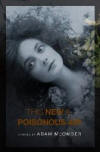This New & Poisonous Air
Judging by the expression of the startled damsel on the cover of This New & Poisonous Air, some things are best left alone. But what purpose does that really serve? There would be no experience. No meaning. It is the unknown’s transformation into a difficult reality that Adam McOmber explores in his strong collection of stories.
Judging by the expression of the startled damsel on the cover of This New & Poisonous Air, some things are best left alone. But what purpose does that really serve? There would be no experience. No meaning. It is the unknown’s transformation into a difficult reality that Adam McOmber explores in his strong collection of stories.
The protagonists in McOmber’s ten tales are seekers. Scientists, townsfolk, historians, and children lead ordinary lives with secrets and daydreams until something distorts their world. Their encounters with outside elements further sharpen a need to know. This also leads to death, loss, redefinition, or the just plain weird. Miriam, the graveyard surveyor who narrates “Beneath Us,” is keenly aware of her “disconnected” personality but nevertheless finds it “morbid” seeing the “festering” catacombs of St. Michael’s Cathedral transformed into a tearoom of “lacquered tables and taffeta” where guests “promenaded through as if in some quiet park on a sunless day.” It also makes the disconnect between her and others wider.
Accompanying the disbelief is one stunning descriptive passage after another. Every page has a paragraph or more worth savoring. McOmber’s gift for detail never infringes on the narrative—indeed, his stories would be artifice without it. The movie palace in “Fall, Orpheum” has the power of capturing celluloid and real life. Grumman’s and Radio City Music Hall do not contain this kind of magic:
When visitors came, they were drawn to our theater, if not to sit for a movie, then just to marvel at the abundance of its Oriental bric-a-brac: silk-tasseled mirrors, brass elephant heads, brèche violette pillars, and foreign deities that peered from every corner of the stonework. The auditorium was a walled courtyard, complete with an accurately constellated sky and a procession of clouds projected on the black ceiling by a magic lantern machine, and the pale glow that fell on us night after night was like a hunter’s jack-light, pulling animals helplessly from the brush.
The mixture of the fantastic and the real is applied to circumstance as well. The title story seems like a fancy, detached description of the Plague, but McOmber achieves what a medieval woodcut can and a medical textbook cannot:
First came the rash, then the cough, an unseen guest knocking. Finally, a spread of boils. The body became a cauldron set upon a fire. Some said the arrival of the death would be signaled by a riderless horse, gaunt and grey, that would wander into the square and eat from dead winter grass. Others thought a voice would issue from the ground—listing the names of those set to die.
It is hard selecting a “favorite” or “best” story. “Fall, Orpheum” has the potential to become a novel or screenplay. There are other equally great reads. Inside “The Automatic Garden” dwells a brokenhearted sculptor commemorating his lost loves with distinctive creativity—and distinctive results. An old man recalls the adventure that he and his first and greatest love shared in “A Memory of His Rising.” A discovery in the attic made “Of Wool” challenges the foundations of love for family, art, and sanity.
There is one story that best represents This New & Poisonous Air. “There Are No Bodies” is a thoroughly reimagined life of Madam Tussaud. She lives the mantra “like the soul, the wax does not perish,” passed on to her spiritually and mentally by her teacher, Herr Curtius. He also gives her a pair of eyeglasses that intrigue Marie Antoinette, who is rendered “blind” when wearing them.
It is very likely that there not would have been a Madam Tussaud had there not been a French Revolution. At Versailles, her life-sized figures were party favors. At the tumbrils, she was forced to make models of guillotined heads, including Marie Antoinette’s:
Beneath a rough cloth there is a shape the size of a serving pitcher. A crescent of brown blood has seeped through the material. And when a jar of wax is placed in her hands—beeswax, her medium of choice—Madame can hear the sound of the bees who made it. The wax itself is frightened. It does not want to approach the head of the Queen.
Madam’s skill with wax saved her life. She lives to enjoy the distinction of being both a successful artist and entrepreneur. With “haunted hands,” she regards her House of Wax as a “carnival joke.” Would tourists lined up around her flagship Museum in London or satellite location in Times Square understand, let alone appreciate, Madam’s—or McOmber’s—perspective: that the Museum was born out of nightmares long before The Reign of Terror?
That, like fantasy and reality, is a matter of interpretation. As This New & Poisonous Air proves tenfold, those two realms go together—and their meeting ground is neither safe nor predictable.





